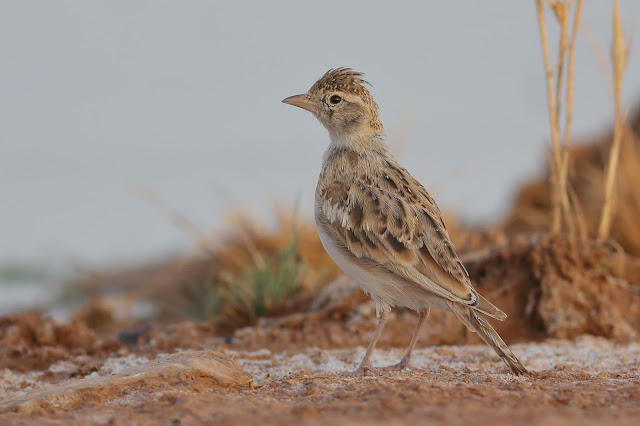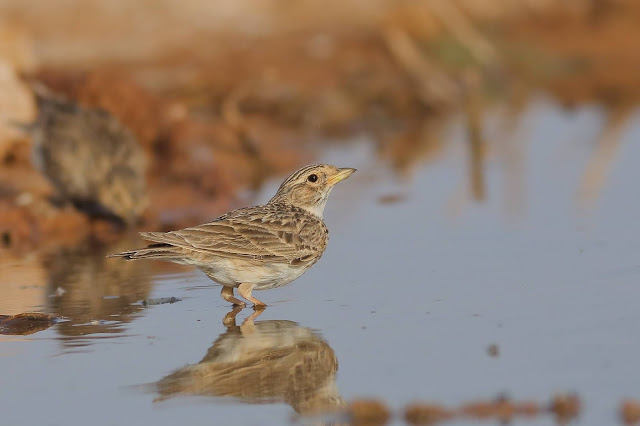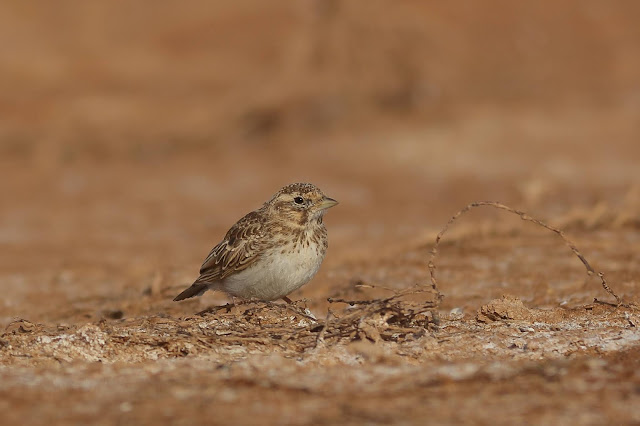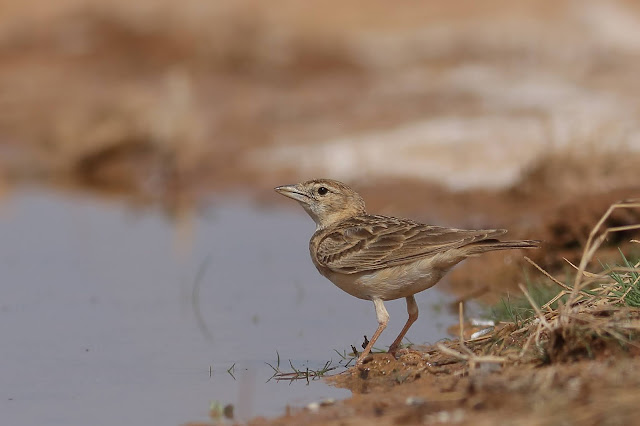Hi again.
En el siguiente enlace podéis ver nuestros próximos viajes fotográficos y de observación de aves y mamíferos nacionales y al extranjero. Espero que os gusten y os animéis a venir conmigo. Una experiencia que nunca olvidareis.
In the following link you can see our next national and foreign Birds and Mammals photographic and observation trips. I hope you like them and I encourage you to come with me. An experience that you will not forget.
Este vez os muestro lo que pude fotografiar en un viaje de tres días por Soria y Zaragoza. La intención era fotografiar gangas ibéricas (Pterocles
alchata) y gangas ortega (Pterocles
orientalis) y para ello fui a un hide en un bebedero cercano a la localidad de Belchite en Zaragoza. Aunque no me gusta estar encerrado en hides hice una excepción para fotografiar estas dos especies que de otra manera son muy difíciles de tener tan cerca. En esta aventura me acompañó mi buen amigo Javier que también tenia muchas ganas de hacer fotografías a estas dos especies.
This time I show you what I could photograph on a three-day trip through Soria and Zaragoza. The intention was to photograph Pin-tailed
Sandgrouse and Black-bellied
Sandgrouse.To achieve this goal I went to a hide in a drinking pound near the town of Belchite in Zaragoza. Although I don't like being locked in hides I made an exception to photograph these two species that are otherwise very difficult to keep so close. My good friend Javier accompanied me on this adventure, who also really wanted to take pictures of these two species.
Como además quería visitar otras localidades para futuros viajes hicimos dos paradas en la provincia de Soria, una a la ida y otra a la vuelta en dos localidades distintas. Es una pena que ya a mediados de julio muchas de las especies que en ellas se pueden ver ya no están tan activas y son más difíciles de observar.
As I also wanted to visit other locations for future trips, we made two stops in the province of Soria, one on the way out and one on the way back in two different locations. It is a pity that already in mid-July many of the species that can be seen in them are no longer so active and are more difficult to watch.
En la mañana del primer día de viaje llegamos al sitio elegido sobre las 10 de la mañana y me dí un paseo por una de las zonas elegidas. Esto es lo que pude fotografiar:
On the morning of the first day of trip, we arrived at the chosen place around 10 am and i did a walk through one of the chosen areas. This is what I was able to photograph:
El sitio es precioso y me imagino que en mayo, la mejor época para visitarlo, estará mucho más bonito.
Place is beautiful and I imagine that in May, the best time to visit it, will be much more beautiful.
Las alondras comunes (Alauda
arvensis) estaban ya alimentado a sus polluelos.
Eurasian Skylark were already feeding their chicks.
Varios corzos se dieron a la fuga cuando me vieron.
Several Roe Deer fled when they saw me.
Había varias parejas de collalba gris (Oenanthe
oenanthe) pero solo este joven se puso lo bastante cerca como para ser fotografiado.
There were several pairs of Northern
Wheatear but only this young man got close enough to be photographed.
Pero sin ningún género de dudas las estrellas de la mañana fueron los bisbitas campestres (Anthus
campestris).
But without any doubt the stars of the morning were the Tawny
Pipits.
Algunos realmente confiados.
Some really tame.
Vimos como esta águila calzada (Aquila
pennata) morfo claro capturaba una presa.
We saw how this pale morpho Booted Eagle captured a prey.
Terrera común (Calandrella
brachydactyla).
Greater Short-toed
Lark.
Cogujada montesina (Galerida theklae).
Thekla
Lark.
Había bastantes mariposas pero como hacía calor y algo de viento no se posaba casi ninguna. Esta es una medio luto ibérica (Melanargia lachesis).
There were quite a few Butterflies but since it was hot and a little windy, almost none settled. This is an Iberian Marbled White.
Vimos bastantes Palpares hispanicus.
We saw quite a few Palpares hispanicus.
Preciosas.
Very beautiful.
Y estas dos plantas llamaron mi atención.
And these two plants caught my eye.
Por la tarde llegamos a Lécera. Me llamo la atención la altura de la torre de la iglesia del pueblo.
In the afternoon we arrived at Lécera. The height of the tower of the town church caught my attention.
El hide estaba situado muy cerca de El Planerón. Es una reserva ornitológica de SEO/Birdlife que cuenta con las protecciones de ZEPA, LIC y está incluida en la Red Natura 2000.
The hide was located very close to El Planerón. It is an SEO / Birdlife ornithological reserve that has the protections of ZEPA, LIC and is included in the Red Natura 2000.
El hide está un poco hundido en el terreno para que las fotografías sean mejores. Nos levantamos muy temprano, 5 am pues teníamos que vernos con la persona que nos llevaba al hide a las 6:30. Aun no alcanzo a entender porqué hay que entrar tan temprano cuando las aves que queríamos fotografiar no llegaron hasta las 9 de la mañana. Menos mal que iba vien acompañado y que había un constante ir y venir de otras especies muy deseadas también.
The hide is slightly sunk into the ground for better pictures. We got up very early, 5 am as we had to meet the person who took us to the hide at 6:30. I still cannot understand why we have to enter so early when the birds we wanted to photograph did not arrive until 9 am. Fortunately, I was in very good company and that there was a constant coming and going of other highly desired species as well.
Es una zona en la que abundan las terreras marismeñas (Calandrella
rufescens).
It is an area where Lesser
Short-toed Lark abound.
Otra de las especies que se pueden ver es la terrera común (Calandrella
brachydactyla). La diferencia más distintiva de estas dos especies es que en la terrera marismeña el pecho lo tienen estriado mientras que las terreras comunes no. En estas dos fotos se aprecia muy bien la diferencia.
Another species that can be seen is the Greater Short-toed
Lark. The most distinctive difference between these two species is that in the Lesser
Short-toed Lark the chest is grooved while in the Greater Short-toed Lark has not. In these two photos the difference is very well appreciated.
Cuando las aves no tienen el plumaje de adultos la cosa se complica un poco más pero si la toma es buena se diferencian bien. En este caso es un subadulto de terrera común (Calandrella
brachydactyla).
When Birds do not have adult plumage the thing is a little bit more complicated but if the photo is good they can be differentiated well. In this case it is a Greater Short-toed
Lark.
También había bastantes cogujadas comunes (Galerida cristata).
There were also quite a few Crested
Larks.
Otra de las especies que me apetecía mucho fotografiar eran las calandrias comunes (Melanocorypha
calandra).
Another species that I really wanted to photograph were the Calandra
Lark.
Os estoy mostrando las fotos del hide según las fui tomando. Por ello hay muchas especies repetidas pero al final del blog espero que os haya servido para poder diferenciarlas. Espero que no se os haga muy aburrido pues hay muchas. En la foto una terrera común (Calandrella
brachydactyla).
I am showing you the photos of the hide as I was taking them. That is why there are many repeated species but at the end of the post I hope it has helped you to differentiate them. I hope it does not make you very boring because there are many. In the photo a Greater Short-toed
Lark.
Algunos escribanos trigueros (Miliaria
calandra) vinieron temprano para beber y para bañarse.
Some Corn Buntings came early to drink and bathe.
Terrera marismeña (Calandrella
rufescens).
Lesser
Short-toed Lark.
Juvenil de la especie anterior.
Juvenile of the previous species.
Calandria común (Melanocorypha
calandra).
Calandra
Lark.
También acudieron algunas urracas comunes (Pica pica).
Some Common Magpie also came.
Terrera común (Calandrella
brachydactyla).
Greater Short-toed
Lark.
Calandria común (Melanocorypha
calandra).
Calandra
Lark.
Perdiz roja (Alectoris
rufa).
Red-legged
Partridge.
Tuvimos mucha suerte pues vino a beber un alcaraván común (Burhinus
oedicnemus).
We were very lucky as a Stone-curlew came to drink.
La visita fue breve pero fructífera.
The visit was brief but it was worth it.
Calandria común (Melanocorypha
calandra).
Calandra
Lark.
Calandria común (Melanocorypha calandra) joven.
Juvenile Calandra Lark.
Terrera marismeña (Calandrella
rufescens).
Lesser
Short-toed Lark.
Terrera marismeña (Calandrella rufescens) juvenil.
Juvenile Lesser Short-toed Lark.
Terrera común (Calandrella
brachydactyla).
Greater Short-toed
Lark.
Calandria común (Melanocorypha
calandra).
Calandra
Lark.
Más perdices rojas (Alectoris
rufa).
More Red-legged
Partridge.
Cogujada común (Galerida
cristata).
Crested
Lark.
Terrera marismeña (Calandrella
rufescens).
Lesser
Short-toed Lark.
Terrera marismeña (Calandrella rufescens) inmaduro.
Immature Lesser Short-toed Lark.
Por fín a las 9:06 am hizo acto de presencia una hembra de ganga ibérica (Pterocles
alchata).
Finally at 9:06 am a Pin-tailed
Sandgrouse female arrived.
Llegó, bebió y se fue.
She came, drank, and left.
Mientras esperábamos a que viniesen más, continuamos con las fotos de otras especies. En la foto una terrera común (Calandrella
brachydactyla).
While we waited for more to come, we continued with photos of other species. In the photo a Greater Short-toed
Lark.
Calandria común (Melanocorypha
calandra).
Calandra
Lark.
Calandria común (Melanocorypha calandra) juvenil.
Juvenile Calandra Lark.
Cogujada común (Galerida
cristata).
Crested
Lark.
Terrera marismeña (Calandrella
rufescens).
Lesser
Short-toed Lark.
Y tras oír el reclamo de las gangas ibéricas (Pterocles
alchata) un bandito se poso para satisfacer su sed. En la foto un macho.
And after hearing the claim of the Pin-tailed
Sandgrouse a few landed to satisfy their thirst. In the photo a male.
Hembra.
Female.
Otro macho.
Another male.
Hembra.
Female.
Macho.
Male.
Una pareja.
A pair.
Ahora ya sabéis el sexo de este ejemplar, si es que no lo sabíais antes de ver las fotos.
Now you already know the sex of this specimen, if you did not know it before seeing the photos.
Uno de los macho se tomó un baño de arena.
A male took a sand bath.
Un macho solo de ganga ortega (Pterocles
orientalis) acudìo a la charca pero no llegó a beber.
A single male of Black-bellied
Sandgrouse went to the pond but he did not drink.
Mientras tanto las gangas ibéricas (Pterocles
alchata) continuaban viniendo y bebiendo.
Meanwhile Pin-tailed
Sandgrouse continued to come and drink.
De repente, llegaron dos hembras de ganga ortega (Pterocles
orientalis).
Suddenly, two females of Black-bellied
Sandgrouse arrived.
Un lagarto ocelado (Timon lepidus) macho también vino a beber.
A male Ocellated Lizard also came to drink.
Precioso.
Beautiful.
Cogujada común (Galerida
cristata).
Crested
Lark.
Macho de ganga ortega (Pterocles
orientalis).
Black-bellied
Sandgrouse male.
Macho y hembra.
Male and female.
Hembra.
Female.
Como en la identificación de estas dos especies, tanto en sexo de las mismas como en la especie en si, ya no tenéis problema omito los nombre de las mismas y su sexo.
As in the identification of these two species, both in the sex and in the species itself, you have no problem I omit the names of them as well as their sex.
Urraca común (Pica pica).
Common Magpie.
Terrera marismeña (Calandrella
rufescens).
Lesser
Short-toed Lark.
Terrera común (Calandrella
brachydactyla).
Greater Short-toed
Lark.
Terrera común (Calandrella brachydactyla) juvenil.
Juvenile Greater Short-toed Lark.
Este fue el macho que tenía el pecho más oscuros de todos los que vinieron.
This was the male with the darkest chest of all that came.
Terrera marismeña (Calandrella
rufescens).
Lesser
Short-toed Lark.
Terrera común (Calandrella
brachydactyla). Fijaos que bien se ve la diferencia entre ambas especies. En la especie anterior, además de tener el pecho barrado, el pico es menor, el dibujo facial está más marcado, no tienen la mancha oscura en el cuello y se la ve como un poco más rechoncha y pequeña que la de la foto.
Greater Short-toed
Lark. Note that the difference between the two species is clear. In the previous species, in addition to having a barred chest, the beak is smaller, the facial drawing is more marked, they do not have the dark spot on the neck and it is seen as a little chubby and smaller than the one in the photo.
También vinieron a beber una pareja de palomas torcaces (Columba
palumbus).
A pair of Common Wood
Pigeon also came to drink.
Cogujada común (Galerida
cristata).
Crested
Lark.
Y este fue el ultimo macho de ganga ortega (Pterocles
orientalis) que vino sobre las 12:00 am y ya no vinieron más de ninguna de las dos especies de ganga.
And this was the last male Black-bellied
Sandgrouse that came around 12:00 am and no more of either gangue species came.
En resumen comentaros que no se cual de las dos especies me gusta más y de ellas no se si los machos o las hembras. Ambas especies son tan espectaculares que me cuesta elegir.
As a summary, I would like to tell you that I do not know which of the two species I like the most and of them I do not know if the males or the females. Both species are so spectacular that I find it difficult to choose.
Después de salir del hide sobre las 13:00 horas nos fuimos a un pueblo cercano para comer que como habíamos desayunado muy temprano el hambre apretaba. En el pueblo había una laguna y en ella una pareja de patos criollos (Cairina
moschata domestica) y le hice una foto al macho que me pareció muy bonito al ser enteramente blanco.
After leaving the hide at around 1:00 p.m., we went to a nearby town to eat, as we had had breakfast very early and hunger was pressing. In the town there was a lagoon and in it a couple of Muscovy Duck and I took a photo of the male that I thought was very nice as she was entirely white.
Por la tarde nos dedicamos a conocer toda la región pero ya ni hicimos muchas fotos pues la mañana había sido muy productiva y eran las mismas especies. Solo saque algunas especies que no habíamos visto en el hide. En la foto una abejaruco europeo (Merops
apiaster).
In the afternoon we explore the area but we didn't even take many photos because the morning had been very productive and they were the same species. I only photograph some species that we had not seen in the hide. In the photo a European Bee-eater.
Tórtolas europeas (Streptopelia
turtur).
European
Turtle Dove.
Culebrera europea (Circaetus
gallicus).
Short-toed
Eagle.
Un macho de cernícalo primilla (Falco naumanni).
A male Lesser
Kestrel.
Y una familia de mochuelos europeos (Athene
noctua).
And a family of Little Owl.
Al día siguiente de la que nos veníamos a Madrid hicimos varias paradas para reconocer otras zonas interesantes para futuras excursiones.
The day after, when we were coming to Madrid we made several stops to recognize other interesting areas for future excursions.
Vimos varias culebreras europeas (Circaetus
gallicus).
We saw several Short-toed
Eagles.
En las entradas al pueblo había almenos dos parejas de aviones roqueros (Ptyonoprogne
rupestris) que se habían reproducido y lo polluelos aun continuaban cerca o en el nido.
At the entrances to the village there were at least two pairs of Crag
Martin that had reproduced and the chicks were still close to or in the nest.
Alimoche común (Neophron
percnopterus).
Egyptian
Vulture.
Y una pareja de collalbas grises (Oenanthe
oenanthe) que estaban llevando comida a sus pollos.
And a pair of Northern
Wheatear who were bringing food to their chicks.
El macho había capturado una araña como alimento para sus crías.
Male had captured a spider as food for chicks.
Si queréis suscribiros a mi blog de los viajes que hacemos pincha en el siguiente enlace: Suscribirse y haz clic en ¿ Quieres suscribirte a nuestro blog?
If you want to subscribe to my blog about the trips we do, click on the following link: Susbcribe and click on Do you want to subscribe to our blog?
Espero que os haya gustado y hasta pronto.
If you want to subscribe to my blog about the trips we do, click on the following link: Susbcribe and click on Do you want to subscribe to our blog?
Espero que os haya gustado y hasta pronto.
I hope you like it and see you soon.





































































































































































Magnífico reportaje Luis, enhorabuena!. No gusta encerrarse en un escondite pero hay que ver los productivos que son.
ResponderEliminarMuchas gracias Paco,
EliminarSi, algunas veces no queda otro remedio para ver de cerca determinadas especies.
Si, en el hide sigo utilizando el monopie pues con el trípode tengo menos movilidad.
Un abrazo,
Luis
Una pregunta, se me olvidaba, desde el escondite sigues usando el monopié?
ResponderEliminarUn abrazo.
Antón Chust. 9 de agosto de 2020
ResponderEliminarLuis.
Me ha encantado este Blog, (también) porque me encantan Todos. Y los paisajes sorianos tambien muy atractivos.
Muchas gracias Antón,
EliminarCelebro que lo hayas disfrutado.
Un abrazo,
Luis
Hola Luis, gracias por compartir esta interesante entrada. Quería preguntarte por la ubicación del hide de belchite desde donde fotografiaste a las gangas. Es un hide público abierto o hay que solicitar permiso? Te agradecería si me puedes facilitar un contacto. Muchas gracias. Un abrazo
ResponderEliminarHola,
ResponderEliminarEs un hide privado que tienes que pagar por el. El contacto es Poto Logistics. y el teléfono de contacto 638887681. Yo conozco a Carles que es con quien hablo. De todos modos es un hide que funciona en julio y agosto, creo recordar. Saludos